Vogelzang SR57E Rancher Cast Iron Coal Stove Review
- November 8, 2023
- 0 comment
When it comes to choosing a reliable, multi-functional stove, particularly for those who appreciate the charm of traditional designs, the Vogelzang SR57E Rancher Cast Iron Coal Stove stands out. This review aims to delve into the specifics of the Rancher, evaluating its performance, features, and suitability for various settings.
Quick Specifications
- Product Type: Freestanding Coal Stove
- Material: All Cast Iron
- BTU Rating: 60,000
- Heating Area Coverage: Up to 100 ft²
- Cooking Surface: Large flare-top with four 8″ lift-out cook lids
- Fuel Type: Bituminous Coal
- Ash Removal: Convenient ash door and tray
- Air Control: Lower spin-draft for air intake control
- Stove Pipe Compatibility: Standard round 6″ stove pipe
- Dimensions: W 24 x H 28 x D 20 inches
- Weight: 200 lbs (approximate package weight)
Performance and Features
Having had the opportunity to review the Vogelzang SR57E Rancher Cast Iron Coal Stove, I can confidently say that it stands out for its quality, functionality, and aesthetic appeal. This stove, a robust creation of the US Stove Company, impresses with its all-cast iron construction, ensuring durability and adding a rustic charm reminiscent of classic stove craftsmanship. Its dual functionality is particularly striking; not only is it an efficient heating unit with a 60,000 BTU rating, capable of warming spaces up to 100 ft², but it also serves admirably as a cooking range. The inclusion of four 8″ lift-out cook lids on the large flare-top offers remarkable cooking flexibility, allowing for the simultaneous preparation of various dishes and easy top-loading, which is a delight for traditional cooking enthusiasts.
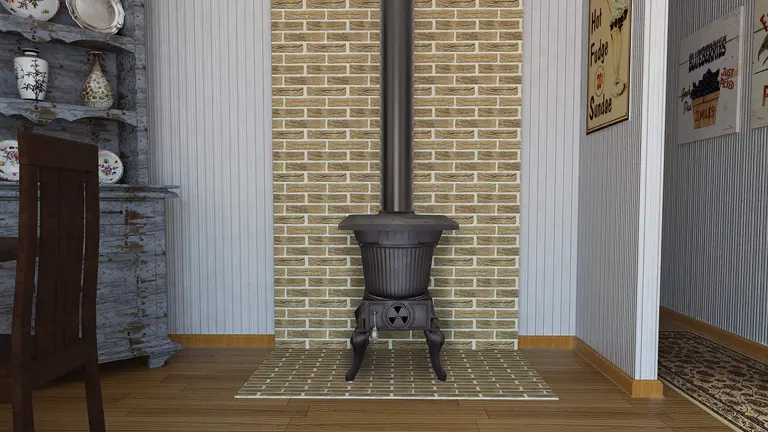
Maintenance, often a concern with coal stoves, is simplified thanks to the convenient ash door, tray, and large ash pan. Additionally, the lower spin-draft system for air control impressed me with its ability to efficiently manage temperature for both heating and cooking. My experience with the Rancher leads me to recommend it highly to anyone seeking a multi-purpose stove that combines the practicality and aesthetic of traditional design with modern functionality. It’s more than just an appliance; it’s a nod to the timeless era of stove design, updated for contemporary use.
Design and Build Quality
I can attest to its outstanding design and build quality. This product embodies a remarkable fusion of durability and classic aesthetic appeal. The all-cast iron construction of the Rancher not only assures long-term durability but also adds to its overall robustness, making it feel exceptionally sturdy and reliable. Its design pays homage to traditional stove craftsmanship, infusing a rustic and timeless charm that can enhance the ambiance of various settings, from cozy cabins to spacious lodges.
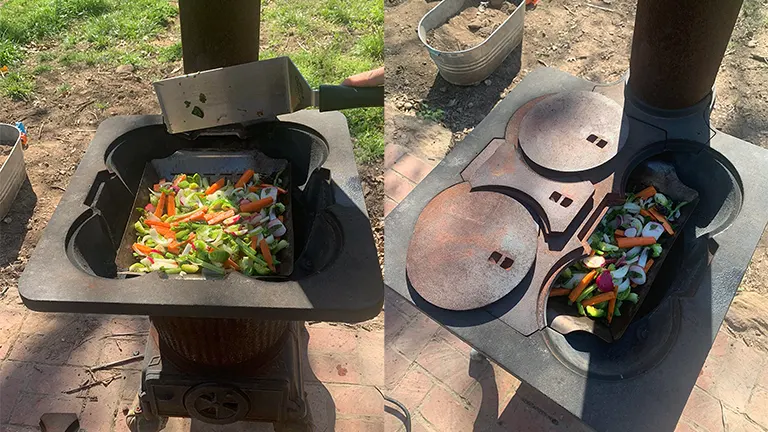
Measuring a substantial yet manageable 24 inches wide, 28 inches high, and 20 inches deep, and weighing around 200 pounds, the Rancher has a commanding presence that complements rather than overwhelms a room. This balance between size and manageability makes it an ideal fit in diverse environments.
Beyond its practical use as a heating and cooking appliance, the Rancher also serves as a decorative piece, enhancing the aesthetic appeal of its surroundings. Its classic design, combined with modern manufacturing standards, positions it as a highly desirable option for those seeking a blend of traditional elegance and functional durability in a stove. In summary, the Vogelzang SR57E Rancher is not just a functional item but a testament to the craftsmanship and quality of the US Stove Company, offering a perfect mix of old-world charm and contemporary reliability.
Parts of Vogelzang SR57E Rancher Cast Iron Coal Stove
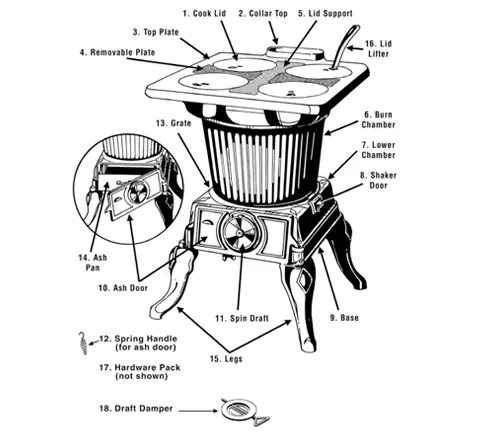
Pros and Cons
Pros
- Robust all-cast iron build ensures longevity.
- Versatile use as both a stove and heater.
- Easy to clean and maintain with an ash disposal system.
- Effective heating with a solid BTU rating.
Cons
- Lack of auto ignition and air wash system.
- Not EPA approved and restricted in certain states (WA, OR, CA).
- No blower or brick-lined firebox.
Best Uses
The Rancher is ideal for hunting cabins, lodges, or homes seeking a classic stove with both heating and cooking capabilities. Its capacity to handle multiple cooking tasks simultaneously makes it a valuable addition to spaces without modern kitchen facilities.
Comparison with Similar Stoves
When compared to other stoves in its category, the Rancher stands out for its traditional design and dual functionality. However, it might lag behind in modern features like auto-ignition or EPA certification, which are present in some contemporary models.
A Guide to Burning Coal in Your Stove
When it comes to burning coal in stoves, understanding the types of coal and operational techniques is crucial. Stoves generally support both Bituminous and Anthracite coal. Anthracite is a superior choice due to its long, even burn time, high heat output, and cleanliness, making it suitable for home use. However, it’s more challenging to use, less available, and costlier than Bituminous.
- Size of Coal: For Bituminous Coal, sizes ranging from large “nut” to small “egg” (1-3/4” to 4” diameter) are recommended. When using Anthracite, opt for “egg” or “broken” sizes between 2-5/16” and 4-3/8”. It’s crucial to buy coal that’s been sized and cleaned to ensure the longevity of your stove. Avoid coal smaller than 1” or larger than 5” in diameter to prevent smothering or inefficient burning.
- Stove Operation: Begin coal fires with wood to heat the fire enough to ignite coal. Use dry pine or other resinous softwoods as kindling, then add hardwood like oak or hickory. Before starting, open the stove pipe damper and doors, and place newspaper and kindling on the grate. Never use flammable liquids to start a fire. Properly placed larger wood pieces form a level base for coal, which shouldn’t be added too early to avoid smothering the fire.
- Burning Bituminous Coal: Once the kindling and wood fire create a bed of established coals, start adding Bituminous coal in layers, ensuring each layer ignites before adding more. Employ the “conical method” with the fire’s peak in the firebox center. Initially, the fire will be orange or yellow, producing smoke that lessens as gases burn off. Ensure proper air entry into the firebox and open the stove pipe damper for efficient burning. Regularly break up the coal bed to avoid caking and clinker formation. Gentle grate shaking is necessary, with minimal movement preferable to excessive agitation.
- Burning Anthracite Coal: Introduce Anthracite coal in thin layers to an established wood fire, taking care not to cut off the draft. Gradually add more coal in heavier layers without exceeding the front liner’s top. Allow the fire to establish before closing the dampers partially. Every setting requires experimentation due to varying chimney drafts. Only add fresh coal when the existing bed burns down to half its depth, and adjust dampers accordingly.
- Banking the Fire: For extended operations like overnight burning, bank the fire by heaping coal along the firebox sides and back. This approach reduces fire intensity without extinguishing it. Start banking early to adjust after the fire stabilizes. To revive a nearly out coal fire, open the ash door and stove pipe damper, place a thin coal layer on the fire, and gently shake the grate after ignition.
Important Cautions
- Do not use coke, charcoal, high volatile Bituminous coal, lignite, or cannel coal.
- Never burn wax or chemically impregnated sawdust logs, as they are meant for fireplaces.
- Avoid filling the stove or furnace above the firebrick or cast iron liner.
Properly burning coal in your stove requires careful attention to coal type, size, and operational techniques. By following these guidelines, you can enjoy efficient and effective heating from your coal stove.
Installation Guide for the Vogelzang SR57E Rancher Cast Iron Coal Stove
When installing the Vogelzang SR57E Rancher, it’s crucial to adhere to specific guidelines to ensure safety and efficiency. Below is a summarized version of the installation instructions:
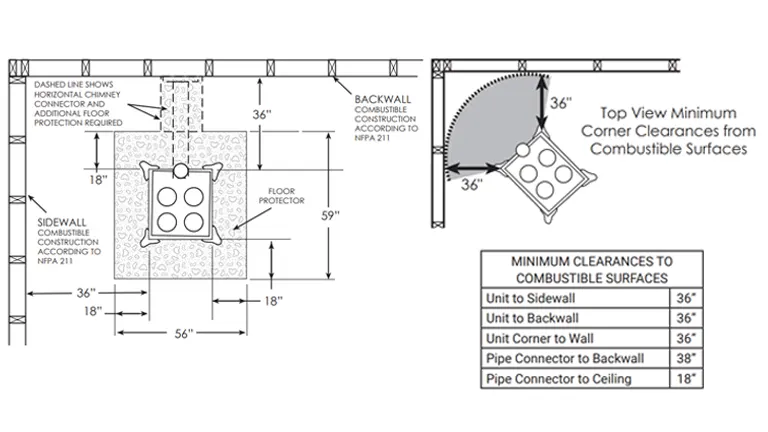
Clearance to Combustibles and Ventilation
- Flooring: The stove must be placed on a non-combustible surface like solid concrete or masonry. If on a combustible floor, a floor protector listed to UL1618 Type 2, at least 1-inch thick with an R-value of 3.0 or greater, is required. The base should extend 18 inches beyond the stove’s sides and front, and also beneath and beyond the sides of any horizontal connector pipe.
- Flue: The stove needs a dedicated flue and should not share a chimney flue with other appliances.
- Location and Stove Pipe Installation: Place the stove on your prepared floor protector, observing clearances to combustibles. Use a cleaned and inspected 6-inch masonry chimney or a manufactured chimney system listed to UL 103 HT. Use a 6-inch diameter, minimum 24 MSG Black or 26 MSG Blue round stove pipe, securing sections with sheet metal screws. Do not use galvanized duct pipe or connect the stove to any air distribution or duct system.
- Clearances Recheck: Ensure clearances from the stove and stove pipe meet local building codes and fire protection ordinances. Drywall faced with brick or stone is considered combustible.
- Mobile Home Installation: Do not install this stove in a mobile home, manufactured home, tent, or trailer.
- Local Compliance: Comply with local building codes. Note that this stove is not UL listed.
Additional Stove Pipe Installation Instructions
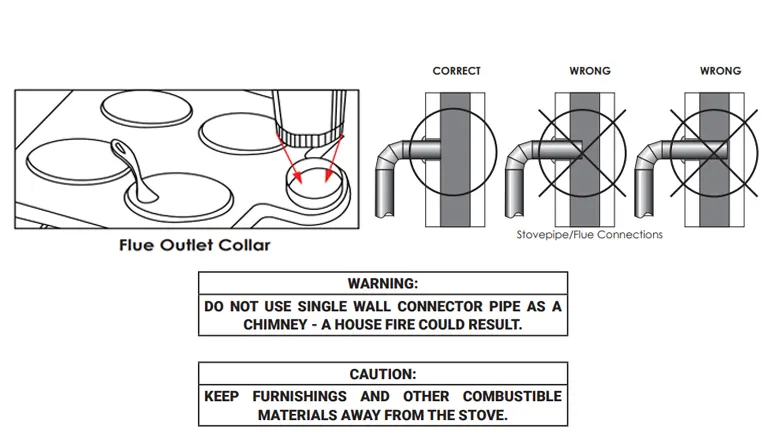
- Pipe Connection: Connect the stove pipe to the stove’s flue outlet collar using sheet metal screws and seal with stove cement.
- Pipe Slope and Clearance: Ensure horizontal pipe runs slope upwards towards the chimney and maintain at least 18 inches of clearance from the ceiling.
- Chimney Flue Penetration: The pipe should not extend into the chimney flue.
- Pipe Stability: Secure pipe/elbow sections with screws at each joint for rigidity.
- Bends and Elbows: Limit to two 90-degree bends in the installation and prefer corrugated elbows for a better seal.
- Chimney Connector Systems: The connector pipe must not pass through any concealed space and must use a UL 103 HT listed chimney system from the first ceiling or wall penetration to the chimney cap. Stick to components from a single manufacturer.
Assembly Instructions for the Vogelzang SR57E Rancher Cast Iron Coal Stove
Assembling the Vogelzang SR57E Rancher requires certain tools and materials. Please note that Vogelzang International Corporation does not provide a warranty for installation or maintenance and is not responsible for any incidental or consequential damages.
Tools Required
- Safety Glasses
- Hearth Gloves
- Pencil
- 6-foot Folding Rule or Tape Measure
- Tin Snips
- Drill (Hand or Electric) with 1/8” dia. Drill Bit (for sheet metal screws)
- Screwdrivers (blade and Phillips types)
- 13mm Nut Driver or Ratchet with 13mm Socket (for 13mm Hex Nuts and Stove Bolts)
Materials Required
- Flooring Protection: 56” x 59” as specified
- Chimney Connection: 6” black steel (24 ga. min.) straight or elbow (as required)
- 1/2″ Sheet Metal Screws
- Chimney: Existing 6” Code-approved, Lined Masonry Chimney or 6” Inside Diameter manufactured chimney system listed to UL 103 HT.
- Furnace Cement (manufacturer recommends Rutland Code 78 or equivalent)
Assembly Process
- Unpack the Stove: Remove the stove from its crate, and take off the cardboard packing and protective poly bag. Keep the cardboard for later use in the assembly process.
- Remove and Identify Parts: Take out parts from inside the stove. These include four lids, three lid supports, one ash door, one lid lifter, four legs, a hardware pack, a Spring Handle, and a draft damper.
- Prepare for Leg Assembly: Lay the flattened carton on the floor and carefully turn the stove over onto the carton.
- Attach Legs: Use the stove bolts to attach the legs to the base of the stove.
- Upright the Stove: Carefully lift the stove to an upright position and place it in the desired location (refer to installation instructions for proper placement).
- Install Lids and Supports: Position the lid supports and place the four lids on the stovetop.
- Install Ash Door: Fit the ash door into its position.
- Install Flue Pipe Draft Damper: This damper must be installed at the top end of the first straight section of the stove pipe. a. Drill two 1/4″ holes centered on either side of the pipe section 6” from the top end. b. Remove the handle from the damper, slide it into the pipe, align it with the drilled holes, and reinsert the handle through the holes and the damper. This damper is crucial for proper operation and meeting EPA emissions requirements.
- Attach Stove Piping: Follow the provided instructions to attach the stovepiping.
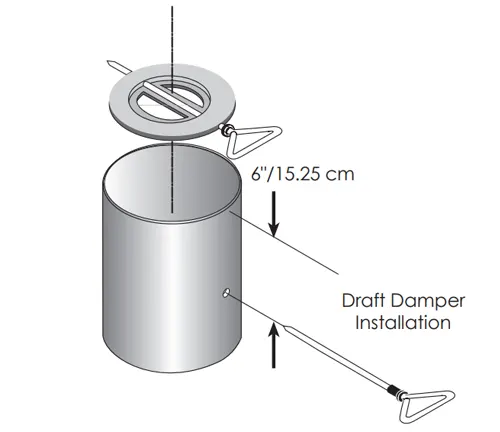
Final Thoughts
The Vogelzang SR57E Rancher Cast Iron Coal Stove emerges as an outstanding choice for those who value a harmonious blend of durability, traditional aesthetics, and versatility in their heating and cooking solutions. Its robust all-cast iron construction not only ensures longevity but also pays homage to the classic art of stove craftsmanship. While it may lack some of the advanced features found in modern stoves, its efficiency in heating and cooking, coupled with the ease of maintenance, renders it a valuable addition, particularly for those who cherish a rustic charm in their living spaces. The stove’s dual functionality as both a heater and a cooking range, accentuated by a large flare-top with practical lift-out cook lids, offers considerable utility, especially in settings like cabins or lodges where space efficiency is crucial. Overall, the Vogelzang SR57E Rancher is more than just a stove; it’s a testament to timeless design, offering warmth and culinary enjoyment in a single, traditional unit.
Thank you for reading this review of the Vogelzang SR57E Rancher Cast Iron Coal Stove. Your thoughts and comments are greatly appreciated, so feel free to share your experiences or queries about this stove in the comments section below. Your feedback helps enrich our community’s understanding and appreciation of traditional stove options.
FAQs
- Can the Vogelzang SR57E Rancher be used in modern homes, or is it better suited for cabins and lodges?
While the Rancher’s rustic design is ideal for cabins and lodges, its functionality and size make it a great addition to modern homes as well, especially for those seeking a traditional touch in their living space. - How does the efficiency of the Rancher compare to modern heating systems?
The Rancher, with a 60,000 BTU rating, is quite efficient in heating spaces up to 100 ft². It may not match the efficiency of some modern heating systems but offers a unique charm and dual functionality as a cooking stove. - Is the installation of the Vogelzang SR57E Rancher something a DIY enthusiast can handle, or does it require professional installation?
While a DIY enthusiast with a good understanding of stoves and local building codes can undertake the installation, professional installation is recommended to ensure safety and compliance with local regulations. - Can the Rancher be used for all types of cooking, or is it limited to certain cooking methods?
The Rancher’s large flare-top with four 8″ lift-out cook lids allows for various cooking methods, from simmering to boiling. It’s suitable for a range of culinary styles, though it might require some adaptation from conventional cooking techniques. - How does the Rancher handle smoke and emissions, and is it environmentally friendly?
The Rancher must be properly vented to handle smoke and emissions. While it’s not EPA-certified, it can be considered environmentally friendly when used responsibly and with the right type of coal. - What are some tips for maintaining the optimal performance of the Rancher?
Regular cleaning of the ash pan, proper ventilation, and using the right size and type of coal are crucial for maintaining the stove’s performance. Additionally, inspecting and cleaning the flue system regularly is important. - Are there any specific accessories recommended for the Vogelzang SR57E Rancher to enhance its usability?
Accessories like a coal hod for managing coal, a stove thermometer to monitor temperature, and extra gaskets for the doors can enhance the usability and maintenance of the Rancher. - In terms of safety, what precautions should be taken when using the Rancher, especially in a household with children or pets?
It’s important to install a safety gate around the stove if there are children or pets in the household. Also, ensure that the stove is installed on a non-combustible floor protector and that all safety clearances are observed. - Can the Rancher be used as the primary source of heating, or is it more suitable as a secondary heat source?
While the Rancher can be used as a primary heat source in smaller spaces, in larger homes it’s more suitable as a secondary or supplemental source of heat. - How does the cost of operating the Vogelzang SR57E Rancher compare to other heating options?
The cost-effectiveness of the Rancher depends on local coal prices and availability. Generally, coal is an affordable fuel source, but prices can vary based on location and demand.

David Murray
Forestry AuthorI'm David Murry, a forestry equipment specialist with a focus on chainsaw operation. With over 13 years of experience, I've honed my skills in operating and maintaining a wide range of machinery, from chainsaws to log splitters. My passion for the outdoors and commitment to sustainable forestry drive my work, which emphasizes safety, efficiency, and staying updated with industry advancements. Additionally, I'm dedicated to sharing my expertise and promoting environmental awareness within the forestry community.

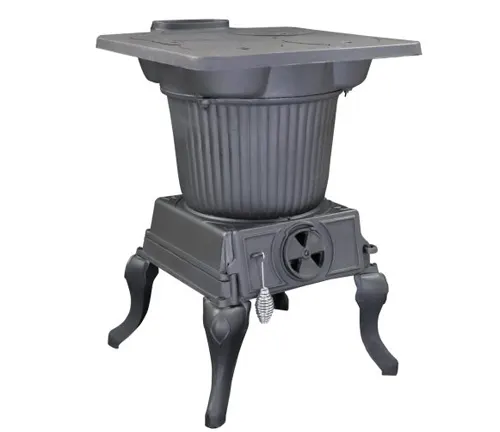


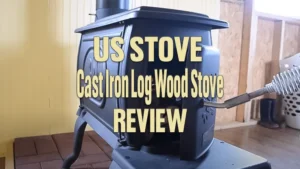
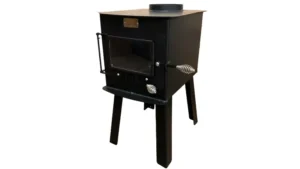
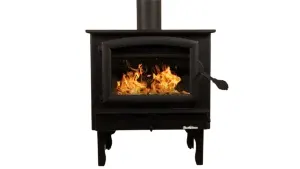

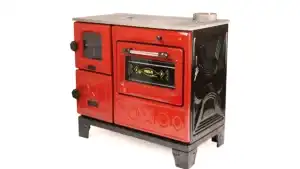
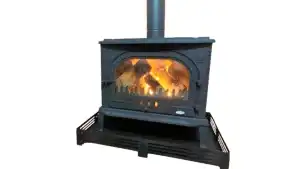
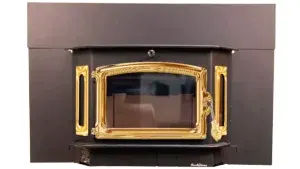
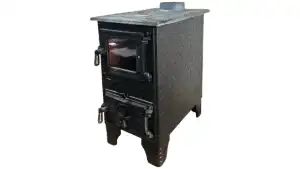
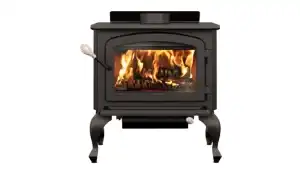

Leave your comment